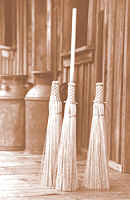
History
Early American Brooms
Early American Brooms
 |
History
Early American Brooms |





|
 Brooms have been used for centuries to sweep caves, cabins and castles. Before 1797, brooms in America were home and hand-made. Tree branches and brush were often used to sweep the floor and clean the ashes from the fireplaces. Sometimes a crude brooms were fashioned by tying something on a stick or handle: straw, hay, fine twigs or corn husks. These crude brooms did not sweep well and fell apart after a short time, even though strong linen twine was often used.
Brooms have been used for centuries to sweep caves, cabins and castles. Before 1797, brooms in America were home and hand-made. Tree branches and brush were often used to sweep the floor and clean the ashes from the fireplaces. Sometimes a crude brooms were fashioned by tying something on a stick or handle: straw, hay, fine twigs or corn husks. These crude brooms did not sweep well and fell apart after a short time, even though strong linen twine was often used.
Cooking at this time was much different than it is today. Stoves did not exist. They had not yet been invented. Cooking was done outside, over an open fire, or in a huge fireplace in the kitchen. Reflector ovens, and pots hanging from chains, were used to prepare the meals. Wood had to be carried in for the fire, and the ashes had to be carried out. In between, the fire had to be tended to provide just the right flame, coals and heat. A big and messy job. So, a broom was an important tool in keeping the hearth area clean. Unfortunately, good brooms did not exist, and dust and ashes were a part of life.
The sweeping quality of brooms changed in 1797 when Levi Dickenson, a farmer in Hadley, Massachusetts, made a broom for his wife, using the tassels of a variety of sorghum (Sorghum vulgere), a grain he was growing for the seeds. She thought Levi’s broom was exceptionally good and told friends and neighbors about it.
Word of Levi’s broom spread quickly throughout the community and people asked him to make one for them. As the demand for these brooms grew, Levi grew more and more of the sorghum. Each sorghum broom he made swept well, but ultimately fell apart as all brooms of that time did . Apparently people were not disturbed by the brooms falling apart, for that was the nature of brooms. Levi was not satisfied with having his "very" fine brooms fall apart, and envisioned a machine which would help him make better brooms, and make them faster. In 1810 the foot-treadle broom machine was invented. This clever machine played an integral part in the Industrial Revolution. While developing the broom machine, its inventors also examined the broom handle, looking for a better way to secure the sorghum tassels to it. These inventors drilled two holes in the handle and inserted split pegs into the round holes. The broom corn was lashed onto the handle and pegs, using linen twine.
By about 1810, the sorghum used in brooms, had acquired a new name, Broom Corn, as the British called all seed bearing plants, "corn." The sorghum also looks similar to the sweet corn plant, and its tassel had become the broom material still used in quality brooms today. Many copies of the 1810 broom machine were made, and soon many one or two man broom shops were making thousands of round brooms each year. Short handled versions were used in and around the large fireplaces used for cooking and heating homes. Long handled brooms were used to sweep the wood or dirt floors throughout the rest of the homes and in shops. In the mid-1820's the Shakers, an industrious religious order, started making brooms, changing the design of the round broom: they eliminated the woven stems up the handle, the holes and the pegs, and used wire to bind their broom to the handle. They then put their broom in a vise, sewing it into the flat brooms we use today. While their flat broom sweeps a rough surface very well, it does not do as quick and thorough a job as the earlier round broom, on a smooth surface. Meanwhile, back in Europe, the birch or besom broom industry, as it was called, had prospered since Saxon times in the sandy heath areas of south-east England, where the birch grows profusely. Known as Besom Squires, the craftsmen were numerous along the Surrey-Sussex border, and they employed assistants who worked individually in the coppices. The brooms were made of birch twigs attached to a handle of ash, hazel or chestnut. By about 1830, there were enough one- or two-man broom shops in the U.S. that 60,000 brooms were being produced annually. This provided enough brooms for domestic needs and put this nation into the broom export business. Brooms were exported to Canada, South America and Europe, but not England, as their Broom Squires obtained an embargo against Yankee brooms. Ultimately these brooms were permitted into England, bring an end to the twig broom business there. As people moved west, it was found that broomcorn grew exceptionally well in the mid-west. Small broom shops appeared in some of the "western" towns, growing broomcorn and making brooms for the settlers. The broom industry grew as tens of thousands of acres of broomcorn was grown annually. Some of these shops became factories, making hundreds of brooms a day, for a growing nation. Our broom making equipment, technology and the use of broomcorn can now be found worldwide. Our broom industry flourished until 1994 when foreign brooms were permitted into the U.S., duty free. The remaining small factories struggle to compete with Mexican-made brooms, while individual broom makers like yours’ truly make a few thousand high quality brooms each year and tell the interesting stories of our history. |
|
|